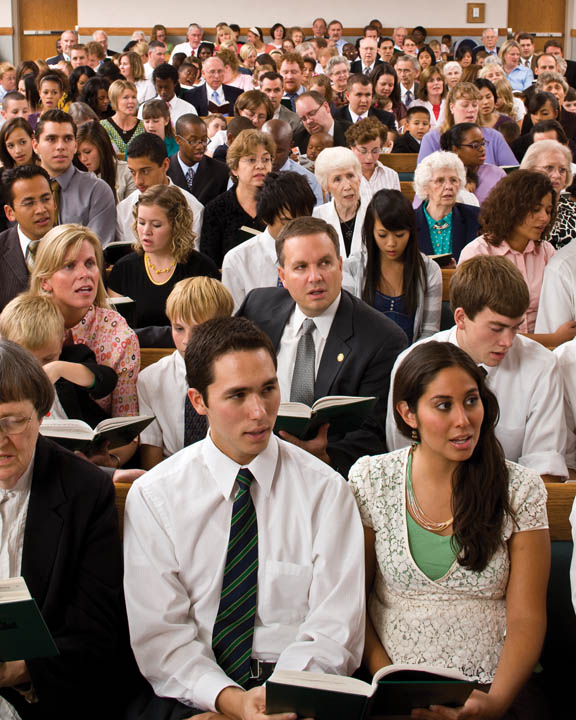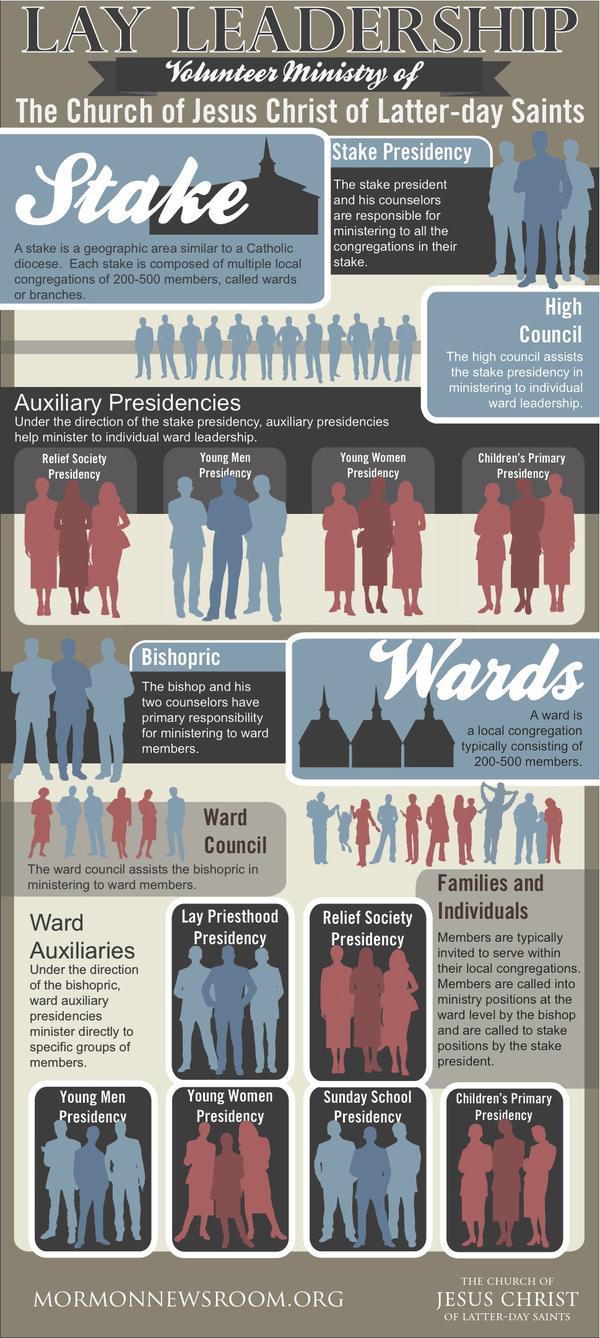Difference between revisions of "Stake"
Dennisangot (talk | contribs) |
(→Stake Missions) |
||
| (One intermediate revision by the same user not shown) | |||
| Line 34: | Line 34: | ||
==Stake Missions== | ==Stake Missions== | ||
| − | As of [[2002]], stake [[mission]]s no longer exist. The work that they did is now what the [[bishop]] and ward mission leader do to ensure that [[Convert Retention|new converts]] are taken care of. This allows full-time [[Mormon missionaries|missionaries]] to better utilize their time finding those who are ready to hear and accept the gospel. The members are now responsible for fellowshipping (making the new members feel welcome and accepted). [[Ward missionaries]], who serve under the direction of the [[ward mission leader]], often teach the new converts very shortly after their [[baptism]]. | + | As of [[2002]], stake [[mission]]s no longer exist. The work that they did is now what the [[bishop]] and ward mission leader do to ensure that [[Convert Retention|new converts]] are taken care of. This allows full-time [[Mormon missionaries|missionaries]] to better utilize their time finding those who are ready to hear and accept the gospel. The members are now responsible for fellowshipping (making the new members feel welcome and accepted). [[Ward missionaries]], who serve under the direction of the [[ward mission leader]], often teach the new converts very shortly after their [[baptism]]. |
| + | |||
| + | [[Image:LDS_Lay_Ministry_Info-Graphic.jpg|200px|thumb|alt=LDS Lay Clergy Info-graphic|center|Click on this graphic to enlarge, then click zoom to read.]] | ||
| + | |||
| + | *[http://www.mormonnewsroom.org/article/mormon-lay-ministry A thorough explanation of the lay ministry of the LDS Church] | ||
| + | <references/> | ||
[[Category:Mormon Life and Culture]][[Category: Church Organization]] | [[Category:Mormon Life and Culture]][[Category: Church Organization]] | ||
Revision as of 23:50, 23 April 2012
In The Church of Jesus Christ of Latter-day Saints, or Mormon Church, a stake is an administrative unit composed of multiple congregations, or wards. A stake may be compared to a diocese in the Roman Catholic Church. The name "stake" derives from the metaphor employed by Isaiah, comparing Zion to a tent fastened securely by stakes:Look upon Zion ... a tabernacle that shall not be taken down; not one of the stakes thereof shall ever be removed, neither shall any of the cords thereof be broken.
Enlarge the place of thy tent ... lengthen thy cords, and strengthen thy stakes.
It can also be considered a reference to the stakes that supported the Biblical tabernacle housing the Ark of the Covenant.
Brief History of Mormon Stakes
The Church's first stake was organized in Kirtland, Ohio, on February 17, 1834, and Joseph Smith, Jr. was the first stake president. The second stake was organized in Clay County, Missouri on July 3 of the same year, with David Whitmer as stake president. The Missouri stake was relocated to Far West, Missouri, in 1836 and the Kirtland Stake dissolved in 1838. A stake was organized at Adam-ondi-Ahman in 1838 and abandoned later that year due to the events of the so-called Mormon War. In 1839, the Church's central stake was established at Nauvoo, Illinois, and William Marks became stake president.
The oldest, still-existing stake in the Church is the Salt Lake Stake. It was originally presided over by John Smith, the uncle of Joseph Smith. Until 1904, it included all of Salt Lake City, but in that year three stakes were split off from it.
Until the 1920's, stakes only existed in communities where a large proportion of the population was made up of members of the church. In the 1920's stakes were organized in California. In the 1930's a stake was organized in New York City and another in Chicago. About the same time, a stake was organized in Hawaii. In the 1950's the first stake outside of North America was organized in New Zealand. Britain received a stake in the late 1950's. The first non-English speaking stake was organized in 1961 in the Netherlands. The first Spanish speaking stake, but second stake in Mexico, was organized in Mexico City in 1962. With the organization of a stake in Tokyo in 1971 all inhabited continents had at least one stake.
Currently in the Church there are more than 2,700 stakes. The first country to be entirely organized in stakes was Tonga. The United States has never reached this point.
Stake Organization
The stake is an intermediate level in the organizational hierarchy of the LDS Church. The lowest level, consisting of a single congregation, is known as a ward or branch. Stakes are organized from a group of wards or branches in the same geographic area. A stake must be composed of at least three wards, and up to a total of sixteen congregations. Most stakes are composed of five to eight wards.
Stakes may be compared to dioceses in other Christian denominations.[1] This analogy is useful in that it indicates that the stake is a hierarchical unit above the basic congregation. However, the comparison is less apt when size is considered. LDS stakes generally have fewer than 5000 members, and Catholic dioceses at times have over one million members. There are many Catholic parishes that have more members than most Mormon stakes do.
Areas where there are not enough church members, or not enough spiritually mature brethren to organize a stake, are organized as districts.
Stake Officers
The presiding officer in a stake is known as the stake president. The president is assisted by two counselors, the three together forming a stake presidency. The stake presidency is assisted in turn by a twelve-member high council, called the stake high council. The members of the stake presidency and stake high council hold the priesthood office of high priest. The stake presidency and the high council handle the administrative and judicial business of the stake.
After a stake president's tenure is complete, or a new stake is to be organized, a new stake president is selected. The selection (or calling) of the new stake president is done by two General Authorities, usually members of the Quorum of the Twelve Apostles or the Quorums of Seventy. are sent to organize the stake. They interview leaders in the stake or stakes from which the new stake will be organized. If the new stake is to be organized from mission districts, the same process takes place. The new presidency is then sustained in the organizing conference; this is also done if the presidency is reorganized later. If a counselor is the only one being replaced, often due to one of the previous counselors moving from the stake boundaries, the stake president will often call and present the counselor himself in the stake conference.
Under the stake president there is a high council. The high council consists of twelve men from all the wards in the stake, who also hold the office of high priest. They serve under the direction of the stake presidency, overseeing the programs of the Church throughout the stake.
Stake Missions
As of 2002, stake missions no longer exist. The work that they did is now what the bishop and ward mission leader do to ensure that new converts are taken care of. This allows full-time missionaries to better utilize their time finding those who are ready to hear and accept the gospel. The members are now responsible for fellowshipping (making the new members feel welcome and accepted). Ward missionaries, who serve under the direction of the ward mission leader, often teach the new converts very shortly after their baptism.
- ↑ Leornard J. Arrington, Brigham Young: American Moses, p. ______

